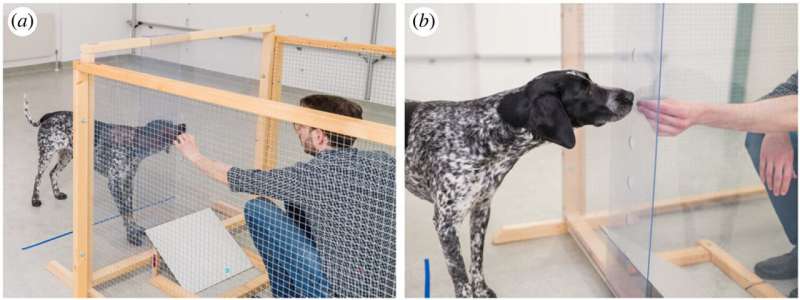January 25, 2023 report
This article has been reviewed according to Science X's editorial process and policies. Editors have highlighted the following attributes while ensuring the content's credibility:
fact-checked
peer-reviewed publication
trusted source
proofread
Can dogs tell the difference between when we are unable to do something for them, versus being simply unwilling?

A team of researchers at the University of Veterinary Medicine Vienna, working with a colleague from AS University of Applied Sciences in the Netherlands, has found evidence that suggests dogs, under some circumstances, are able to understand the intentions of people that they do not know. In their paper published in the journal Proceedings of the Royal Society B, the group describes experiments they carried out with treats given to a variety of dogs.
Prior research has shown that most primates have some degree of understanding of the intentions of others based on observed behaviors. Whether dogs are able to do so has been a matter of debate. In this new effort, the researchers looked for concrete evidence of the ability in dogs.
The work by the researchers involved building a small cage with plastic mesh on three sides and a clear plastic panel with holes drilled in it on the fourth. The cage was then placed in an otherwise empty room. Experiments were conducted by having a researcher unknown to the dog subjects sit inside the cage.
Dogs were introduced one at a time, approaching the cage on the side with the plastic panel because the researcher was holding a treat there. The researcher could pass the treat to the dog through one of the drilled holes. To test for intent, the researchers sometimes only pretended they were going to give the treat to the dog and instead held on to it. Other times, they pretended to drop the treat accidently. In either case, the dog never got the treat. But the reason for it differed.
As 48 dogs were tested, they were watched and recorded by multiple cameras focused on different parts of their body. The video from all of the cameras was then used to train a machine-learning 3D algorithm that was used to evaluate the reactions of the dogs during the testing.
In looking at the results, the researchers found that when the treat was held back intentionally, the dogs tended to respond by backing up and sitting or lying down. When the treat was withheld accidently, the dogs responded in a more forgiving manner, continuing to make eye contact, wagging their tails and maintaining proximity to the researchers.
The researchers suggest the behavior of the dogs showed that they were clearly able to understand the intent behind the offering of the treat.
More information: Christoph J. Völter et al, Unwilling or unable? Using three-dimensional tracking to evaluate dogs' reactions to differing human intentions, Proceedings of the Royal Society B: Biological Sciences (2023). DOI: 10.1098/rspb.2022.1621
Journal information: Proceedings of the Royal Society B
© 2023 Science X Network

















